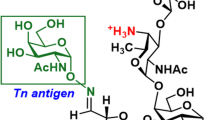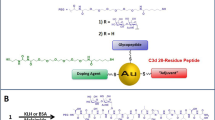Abstract
RP215 monoclonal antibody (Mab) was shown to recognize carbohydrate-associated epitope(s) in the heavy chains of cancer cell-expressed immunoglobulins, designated in general as CA215 pan cancer marker. Growth inhibitions of tumor cells in vitro by RP215 Mab and antibodies against its anti-idiotype (anti-id) antibodies were investigated. Polyclonal rabbit anti-id antibodies and the corresponding rat anti-id Mabs were generated and characterized. Following immunizations in mice, antisera raised against anti-id antibodies were analyzed by typical immunoassays. It was observed that mouse anti-anti-id sera (Ab3) revealed binding affinity and specificity to CA215 that are comparable to those of RP215. Both RP215 and Ab3 were shown to induce apoptosis of cultured cancer cells in vitro by TUNEL and MTT assays. These experimental observations were consistent with that of in vivo tumor growth inhibition by RP215 in previous nude mouse experiments. Therefore, heterologous or homologous anti-id antibodies of RP215 that contain the internal image of its specific epitope in CA215 may serve as effective anti-cancer vaccines for therapeutic treatments of various cancers in humans. The relative stability of RP215-specific carbohydrate-associated epitope was compared to that of human IgG at extreme pH’s (≤2 or ≥12) or following NaIO4 treatments. The major molecular forms of CA215 were further documented with various enzyme immunoassays and found to have similar secondary structures to those of normal human immunoglobulin G.




Similar content being viewed by others
Abbreviations
- Ab2:
-
Anti-idiotype antibody, or anti-id antibody
- Ab3:
-
Antibody or antiserum against anti-id antibody, or anti-anti-id antibody
- Anti-id:
-
Anti-idiotype
- DAB:
-
Diaminobenzidine (substrate for horse radish peroxidase)
- ELISA:
-
Enzyme-linked immunosorbent assay, or EIA
- F(ab′)2 :
-
Fragments obtained following pepsin digestions of immunoglobulin G
- HRP:
-
Horse radish peroxidase
- Mab:
-
Monoclonal antibody
- MTT:
-
3-(4,5-Dimethylthiazol-2-yl)-2,5-diphenyltetrazolium bromide
- RP215-HRP:
-
Horse radish peroxidase-labeled RP215 monoclonal antibody
- TUNEL:
-
Terminal deoxynucleotidyl transferase dUTP nick end labeling
References
Liu H-D, Zheng H, Li M, Hu D-S, Tang M, Cao Y (2007) Upregulated expression of kappa light chain by Esptein-Barr virus encoded latent membrane protein 1 in nasopharyngeal carcinoma cells via NF-κB and AP-1 pathways. Cell Signal 19:419–427
Zheng H, Li M, Ren W, Zeng L, Liu H-D, Hu D, Deng X, Tang M, Shi Y, Gong J, Cao Y (2007) Expression and secretion of immunoglobulin alpha heavy chain with diverse VDJ recombinations by human epithelial cancer cells. Mol Immunol 44:2221–2227
Li M, Feng D-Y, Ren W, Zheng L, Zheng H, Tang M, Cao Y (2004) Expression of immunoglobulin kappa light chain constant region in abnormal human cervical epithelial cells. Int J Biochem Cell Biol 36:2250–2257
Qiu X, Zhu X, Zhang L, Mao Y, Zhang J, Hao P, Li G, Lv P, Li Z, Sun X, Wu L, Zheng J et al (2003) Human epithelial cancers secrete immunoglobulin G with unidentified specificity to promote growth and survival of tumor cells. Cancer Res 63:6488–6495
Kimoto Y (1997) Expression of heavy-chain constant region of immunoglobulin and T-cell receptor gene transcripts in human non-hematopoietic tumor cell lines. Genes Chromosomes Cancer 22:83–86
Zhu X, Li C, Sun X, Mao Y, Li G, Liu X, Zhang Y, Qiu X (2008) Immunoglobulin mRNA and protein expression in human oral epithelial tumor cells. Appl Immunohistochem Mol Morph 16:232–238
Babbage G, Ottensmeier CH, Blaydes J, Stevenson FK, Sahota SS (2006) Immunoglobulin heavy chain locus events and expression of activation-induced cytidine deaminase in epithelial breast cancer cell lines. Cancer Res 66:3996–4000
Geng L-Y, Shi Z-Z, Dong Q, Cai X-H, Zhang Y-M, Cao W, Peng J-P, Fang Y-M, Zheng L, Zheng S (2007) Expression of SNC73, a transcript of the immunoglobulin α-1 gene, in human epithelial carcinomas. World J Gastroenterol 13:2305–2311
Chen Z, Gu J (2007) Immunoglobulin G expression in carcinomas and cancer cell lines. FASEB J 21:2931–2938
Forconi F, Sahota SS, Raspadori D, Mockridge CI, Lauria F, Stevenson FK (2001) Tumor cells of hairy cell leukemia express multiple clonally related immunoglobulin isotypes via RNA splicing. Blood 98:1174–1181
Lee G, Laflamme E, Chien C-H, Ting HH (2008) Molecular identity of a pan cancer marker, CA215. Cancer Biol Ther 7:91–98
Lee G, Ge B (2009) Cancer cell expressions of immunoglobulin heavy chains with unique carbohydrate-associated biomarker. Cancer Biomarkers 5:177–188
Lee CYG, Chen KW, Sheu FS, Tsang A, Chao KC, Ng HT (1992) Studies of a tumor associated antigens, COX-1, recognized by a Mab. Cancer Immunol Immunother 35:19–26
Lee G, Chu R-A, Ting HH (2009) Preclinical assessment of anti-cancer drugs by using RP215 Mab. Cancer Biol Ther 8:161–166
Lee G (2009) Cancer cell-expressed immunoglobulins: CA215 as a pan cancer marker and its diagnostic applications. Cancer Biomarkers 5:137–142
Rice J, Ottensmeier CH, Stevenson FK (2008) DNA vaccines: precision tools for activating effective immunity against cancer. Nat Rev Cancer 8:108–120
Lowder JN, Meeker TC, Campbell M, Garcia CF, Gralow J, Miller RA, Warnke R, Levy R (1987) Studies on B lymphoid tumors treated with monoclonal anti-idiotype antibodies: correlation with clinical responses. Blood 69:199–210
Lopez-Diaz de Cerio A, Zabalegui N, Rodriguez-Calvillo M, Inoges S, Bendandi M (2007) Anti-idiotype antibodies in cancer treatment. Oncogene 26:3594–3602
Kuo C-Y, Sun P, Lee CYG (1988) Sperm antibodies induced by anti-idiotype antibodies: a strategy in development of immunocontraceptive vaccines. J Reprod Immunol 13:193–209
Laniyu E (1986) Preparation of F(ab′)2 fragments from mouse IgG of various subclasses. In: Langone JJ, Van Vunakis H (eds) Methods in enzymology, vol 121. Academic Press, New York, pp 652–663
Losman MJ, Leung S-O, Shih LB, Shevitz J, Shukla R, Haraga L, Goldenberg DM, Hansen HJ (1995) Development and evaluation of the specificity of a rat monoclonal anti-idiotype antibody, WN, to an anti-B-cell lymphoma monoclonal anibody, LL2. Cancer Res 55:5978s–5982s
Choi J-H, Choi K-C, Auersperg N, Leung PCK (2006) Differential regulation of two forms of gonadotropin-releasing hormone messenger ribonucleic acid by gonadotropins in human immortalized ovarian surface epithelium and ovarian cancer cells. Endocr Relat Cancer 13:641–651
Chen A, Kaganovsky E, Rahimipour S, Ben-Aroya N, Okon E, Koch Y (2002) Two forms of gonadotropin-releasing hormone (GnRH) are expressed in human breast tissue and overexpressed in breast cancer: a putative mechanism for the antiproliferative effect of GnRH by down-regulation of acidic ribosomal phosphoproteins P1 and P2. Cancer Res 62:1036–1044
Freed KA, Brennecke SP, Moses EK (2005) Gene expression of the constant region of the heavy chain of immunoglobulin G is down-regulated in human decidua in association with preeclampsia. J Reprod Immunol 68:105–120
Hong I-S, Cheung AP, Leung PCK (2008) Gonadotropin-releasing hormones I and II induce apoptosis in human granulose cells. J Clin Endocrinol Metab 93:3179–3185
Lee G, Wu Q, Li C-H, Ting H-H, Chien CH (2006) Recent studies of a new carbohydrate-associated pan cancer marker, CA215. J Clin Ligand Assay 29:47–51
Acknowledgments
The Industry R&D Fellowship (IRDF, #360647) from NSERC (Natural Sciences and Engineering Research Council of Canada) to BG was acknowledged. This project was supported in parts by Vancouver Biotech Ltd (#080201). The NSERC and IRAP support of the following co-op students or research assistants are also acknowledged: C. Zhang, D. Tsui, E. Laflamme, A. Spreeuw and K. Huang.
Conflict of interest statement
GL is co-founder of Vancouver Biotech Ltd.
Author information
Authors and Affiliations
Corresponding author
Rights and permissions
About this article
Cite this article
Lee, G., Ge, B. Inhibition of in vitro tumor cell growth by RP215 monoclonal antibody and antibodies raised against its anti-idiotype antibodies. Cancer Immunol Immunother 59, 1347–1356 (2010). https://doi.org/10.1007/s00262-010-0864-7
Received:
Accepted:
Published:
Issue Date:
DOI: https://doi.org/10.1007/s00262-010-0864-7




